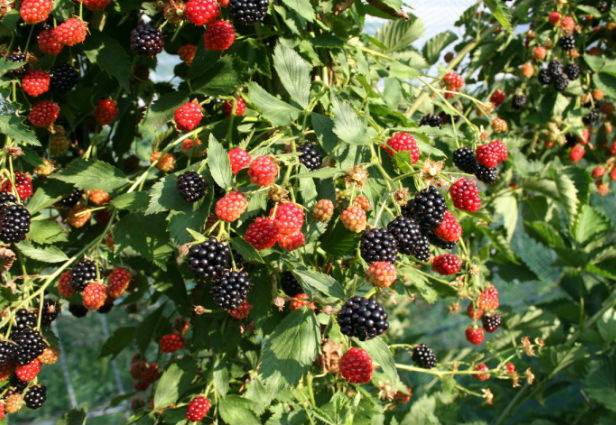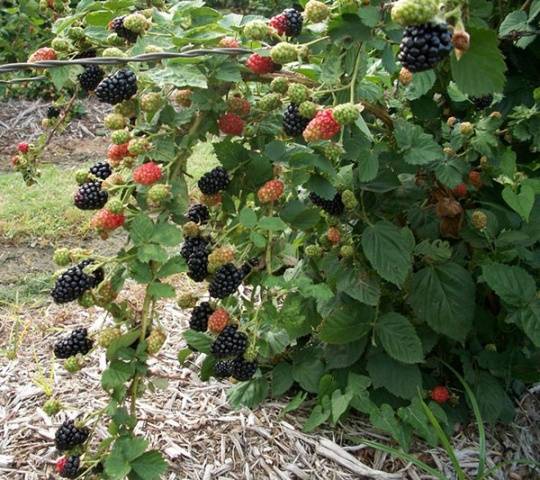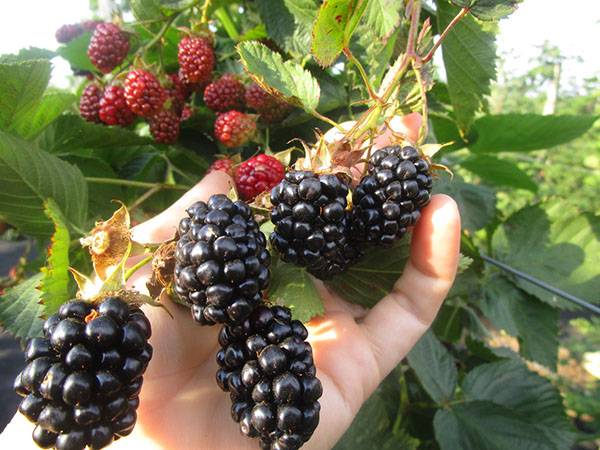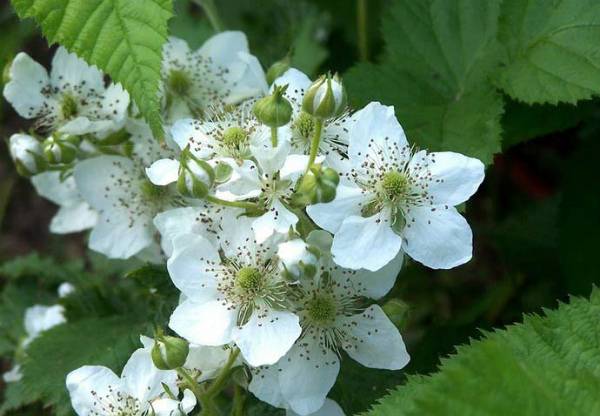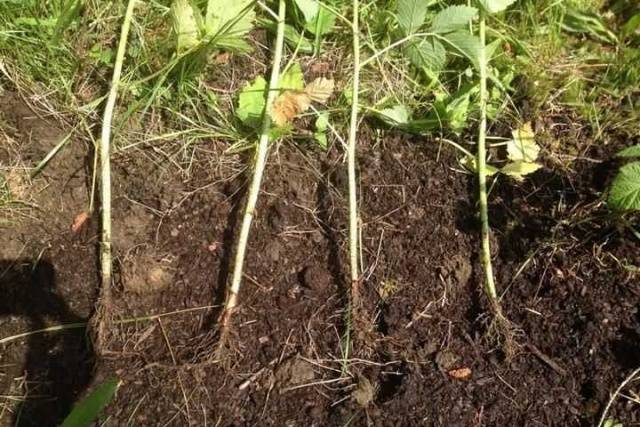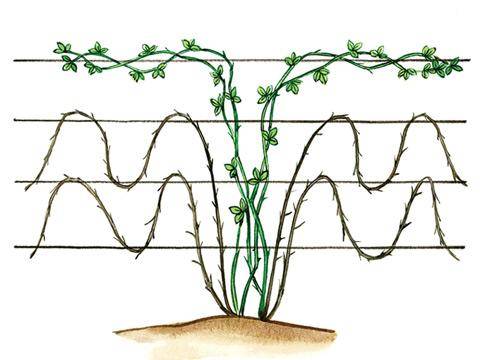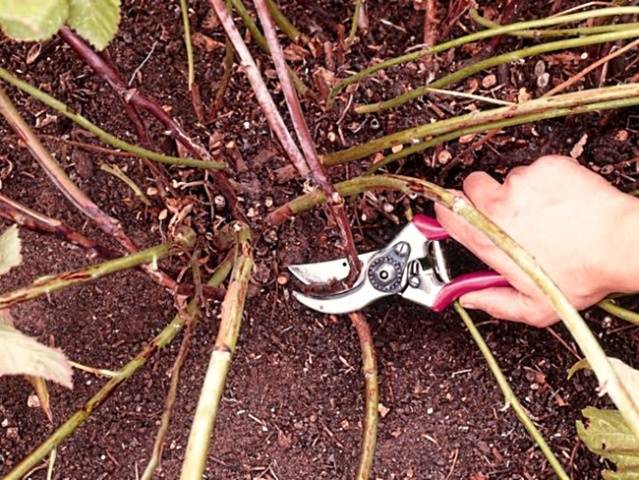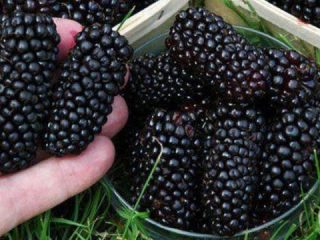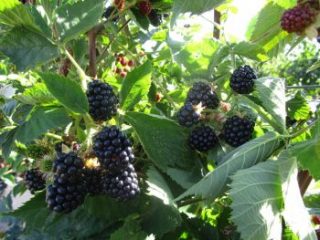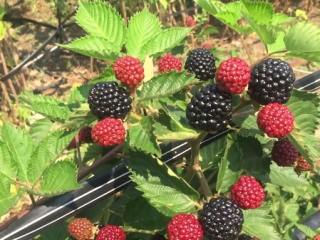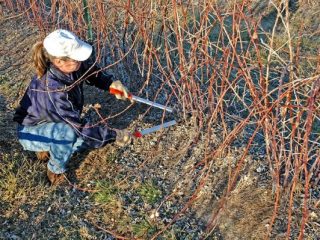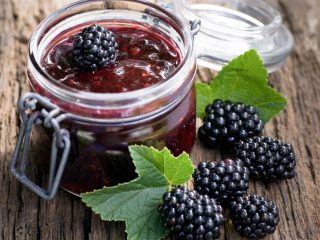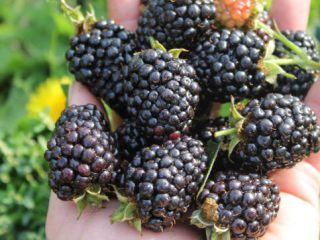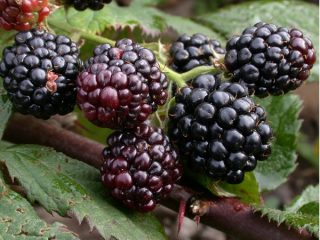Content
Blackberries are a garden crop of North American origin, which is also grown with pleasure in Russia. There are enough varieties of this berry that can grow safely and bear fruit well in Russian conditions. For example, many gardeners plant Navajo blackberries on their plots. Let's consider the features of this variety, its characteristics and the rules of agricultural cultivation.
History of selection
The Navajo blackberry variety is just over 20 years old. It was bred in 1987 in the USA by scientists at the University of Arkansas along with other varieties of this crop, the common feature of which is the absence of thorns on the shoots. The name of the variety - Navaho (Navajo) - comes from the name of one of the Indian peoples.Several varieties were chosen as parent forms for it: Thornfree, Cherokee, etc. Now blackberries of this variety are popular not only in their homeland, but also in European countries and in Russia.
Description of the berry crop
Blackberries are a subgenus of the Raspberry genus, which has 8 species, 2 of which are used in cultural cultivation. These are subshrubs with flexible erect or recumbent shoots. Blackberries are grown for their sweet or sour-sweet berries, which in shape and appearance resemble raspberries, but are not red, but dark blue or black in color.
General idea of the variety
This blackberry bush is powerful, with tall (up to 2 m) erect shoots. They are quite strong, but can bend under the weight of the berries, so they need to be tied up after they reach a height of 1.5 meters or more. It is distinguished by strong shoot formation, therefore it forms a lot of shoots.
In addition to the classic Navajo variety, the Navaho Bigandearly hybrid obtained from it is also known. This is not a full-fledged variety with characteristics different from the original form, but a hybrid form. The authors of this creation claim that the hybrid Navajo blackberry variety produces taller shoots (up to 2.7 m) and larger berries that ripen faster and have a dessert taste. This is evidenced by the name of the hybrid, which means “large and early.”
Berries
The berries of the Navajo blackberry variety are short-conical in shape, aligned in size and shape, and relatively small (compared to other varieties of this crop) in size. Their weight is in the range of 4-7 g. But this feature is well compensated by the huge number of berries ripening on one plant.For example, 1 adult young bush can contain more than 0.5 thousand berries.
The berries of Navajo blackberries are dark blue (deep black in the biological ripeness phase), shiny, and have an excellent moderately sweet taste, which tasters rated 4.9 points out of 5, and many gardeners call it almost a standard. The berries can retain their commercial and taste qualities for 5 days. The seeds of this blackberry are small, almost invisible, which is also considered an advantage of the variety and is appreciated by blackberry lovers. The berries are dense, so they withstand transportation well.
Characteristic
The Navajo variety has qualities that attract many gardeners, both amateurs and professionals, to it. That is why gardeners throughout Russia are increasingly choosing it for planting on their plots.
Main advantages
Navajo blackberries are considered an unpretentious variety that does not require special care. It tolerates drought well, can grow on almost any soil (but prefers fertile sandy loam and loam), has good frost resistance (up to - 20˚C), therefore, in regions where the temperature in winter does not fall below this indicator, it can grow without shelter. In the rest, the bushes will need to be covered. There are no thorns on the shoots of this blackberry, which makes manual harvesting much easier.
Flowering period and ripening time
The Navajo variety has a late ripening period, and therefore begins to bloom late - in the central zone of the Russian Federation, the bushes throw out flowers in the second half of June. The berries ripen, as stated in the characteristics of the variety, in August or September. This is influenced by the weather conditions of a particular season, the condition of the plants and, to some extent, the planting location (sunny or tennis-like location).
Yield indicators, fruiting dates
Thanks to the huge number of berries, the yield of Navajo blackberries is quite high and amounts to 9 kg per 1 sq. m. Fruiting in the bushes is extended and lasts from 3 to 4 weeks.
Area of application of berries
Navajo blackberries are mostly eaten fresh, but they can also be used in homemade preparations. They are used to make compotes, jam, preserves, filling for baked pies, and frozen in the refrigerator.
Resistance to diseases and pests
It has been noted that blackberries of this variety are not prone to diseases and pest attacks, so there is no need to treat the bushes with pesticides unless required. This reduces the cost, time and effort spent by the gardener on growing plants.
Advantages and disadvantages
The Navaho blackberry variety has many positive qualities, including:
- self-fertility (pollinators are not required for ovary formation);
- high productivity due to abundant fruit formation;
- undemanding to cultivation conditions;
- ease of care (bushes with erect shoots are easier to care for and easier to prune);
- easy access to the berries during the picking process due to the absence of thorns and the fact that the berries are located in large clusters;
- good preservation of the berries and their transportability (despite the fact that they are juicy, the berries remain elastic and do not leak for almost a week after picking);
- excellent dessert taste of blackberries.
The variety also has disadvantages. Those who grew it note that with high humidity and cool summers, yields decrease; the taste of the berries is affected by the amount of heat and light radiation absorbed by the plants. Another disadvantage is the need to remove excess shoots that thicken the bushes.
Reproduction methods
Navajo blackberries are propagated by rooting shoot tips and basal suckers. This is very simple to do: when the young shoots reach about 0.6 m, their tops are cut off. After this, new shoots begin to grow from the axils of the leaves. They, together with the shoot, are pressed to the ground and buried to a shallow depth. In the fall or next spring, they are dug up, cut off from an adult plant and transplanted to a new place. When the root shoots reach a height of 0.2 m, they are dug up along with a lump of earth and transplanted to new beds.
Landing rules
With proper care, each blackberry bush can grow and bear fruit successfully for 10-15 years and where and how it was planted has a big influence on this. This is why planting and caring for Navajo blackberries in the spring is of great importance for the entire subsequent life of the plants and their productivity.
Recommended timing
The best time to plant bushes is spring; in the northern regions they can also be planted in early summer. Blackberries are not planted in autumn, as young plants do not tolerate winter well, especially long and cold ones.
Choosing a suitable location
The place for the bushes is chosen to be sunny and warm, but partial shade is also acceptable. It is impossible to plant in a place that is too shaded: the plants will constantly receive less light and heat, which will make the berries small and sour. You can place blackberries on an open, flat area or on small slopes, near fences, outbuildings, the main thing is that the plants are protected from strong winds and drafts.
Soil preparation
Navajo blackberries do not have any special requirements for soil type, but its quality must be high. The soil must be fertile, humus, light, loose and airy.Acidity is neutral, slightly increased is acceptable. The soil is preferably moisture-absorbing, but not swampy: too high humidity is contraindicated for the crop; in wet soil, plant roots can rot.
You can prepare a plot for blackberries in autumn or spring. To do this, it is cleared of plant residues, dug up and fertilized with organic matter or mineral fertilizers. Shortly before planting, the soil is leveled with a rake and holes are made.
Selection and preparation of seedlings
Navajo blackberry seedlings must be healthy, without damage or signs of disease, and well developed. They should have strong roots and strong shoots with green (not pale) leaves. Plants with dry roots or poorly growing shoots are not suitable for planting. Before planting blackberries, their roots are moistened and placed in a solution of a root formation stimulator, such as Kornevin, for the time specified in the instructions for use of the drug.
Algorithm and landing scheme
The distance between young plants placed should be at least 1.5-2 m. The holes for them should be voluminous: at least 0.6 m in diameter and depth. When planting, pour 1 bucket of humus and 2 tbsp into each of them. ash. Fertilizers are covered with a layer of soil on top so that the roots do not touch them.
Navajo blackberry seedlings are planted in the following sequence:
- Moisten the soil in the holes.
- The bush is placed in the middle and its roots are straightened.
- Cover it with soil up to the growth buds.
- The shoots are cut with pruning shears, leaving 2-3 buds on each.
- The soil surface is mulched with hay, sawdust or straw, and non-acidic peat.
A strong support is placed near each bush, to which long shoots will be tied.Second option: supports are installed along the edges of the row, and 2-3 rows of wire are stretched between them, which will support the bushes.
Subsequent care of the crop
Agricultural technology for thornless Navajo blackberries is not at all complicated. If you plant it correctly, then the first berries will appear on the bushes already next season, and starting from the 4th year you can expect a bountiful harvest. The main task for the gardener at this time should be to provide the plants with the necessary amount of moisture and fertilizers, form bushes and prepare them for winter.
Growing principles
It is advisable to tie up the bushes of this blackberry, although it is not a tall variety. They are grown on trellises, but as an alternative, special pruning of the main and side shoots on the bush can be used.
Necessary activities
Growing Navajo blackberries involves performing a set of standard agrotechnical work: watering, loosening (or mulching), and weeding. Water the bushes abundantly, especially during the period when blackberries bloom and set fruit. But there is no need to water the blackberries; they cannot tolerate too wet soil. If the area occupied by crops is small, a drip irrigation system can be installed on the site. It will distribute water evenly and save it. After watering or rain, the soil is loosened and weeded weeds or lay a layer of mulch on the soil, which protects it from rapid drying out. Water-recharging irrigation is carried out only if the autumn is dry.
Shrub pruning
Navajo blackberries are distinguished by the fact that they produce strong shoots, so they are pruned starting from the second year of life. In late spring, the tops of young shoots that have grown to 1 m are cut off.From this, side shoots begin to grow, the volume of the bush increases, and fruit formation increases.
The formation of the Navajo blackberry bush continues in the fall, since it bears fruit on last year's shoots, which produce berries only one year. For this reason they need to be cut out. This is done in the fall, cutting them off at the root with pruning shears. Leave 3-4 new shoots, while shortening them.
Preparing for winter
Blackberry bushes need to be covered for the winter. To do this, the shoots, when the foliage falls from them, are removed from the trellis, tied together and bent to the ground. The top is covered with a covering material: synthetic or vegetable, for example, spruce branches. Under such protection, blackberries tolerate winter cold well.
Diseases and pests: methods of control and prevention
All blackberry varieties of American selection, to which Navajo belongs, are considered resistant to pests and diseases. It has been established that even aphids and gall midges settle on its bushes quite rarely. But, nevertheless, this crop can be affected by spider and blackberry mites, raspberry beetles, powdery mildew, seproriosis and anthracnose. If insects or signs of disease appear, blackberries should be treated with appropriate insecticides or fungicides.
Conclusion
Blackberries of the Navaho variety are considered the most unpretentious, and therefore are popular among Russian gardeners. With proper care, it can produce excellent harvests for many years and bring joy to the owner.
Reviews
Gardeners who grew this blackberry leave their reviews about the Navajo variety.
Video about Navajo blackberries:
